Higher stocking densities possible

Due to their high consumer appeal, interest in culturing cobia has increased greatly in the United States over the last 10 years. Cobia can reach 6 kg in one year, eat pelleted diets and spawn in captivity. Methods exist for the production of juveniles for ongrowing operations.
Today, successful cobia farms using net pen culture are found in Taiwan, China, Southeast Asia, Central and South America, and the Caribbean. However, the growth of aquaculture using net pens in the United States continues to be beset with regulatory and other hurdles. The establishment of land-based recirculating aquaculture system (RAS) technologies for cobia production could mitigate some of these issues.
Fish density
The authors have demonstrated juvenile cobia are well suited for culture in production-scale recirculation systems. However, the threshold density that results in reduced RAS productivity when market-size cobia are reared to over 2 kg has not been reported.
A production density in excess of a critical threshold can result in a negative relationship between stocking density and fish production that is typically attributed to competition, agonistic behavior or space limitation. Therefore, a study was conducted to compare the production characteristics, body compositions and fillet yields of cobia reared in production-scale RAS.
Cobia growth trial
For the 119-day growout trial, cobia with an initial mean weight of 322 g were stocked at 35, 70 or 106 fish/tank to attain final in-tank biomasses of 10, 20 or 30 kg/m3 at harvest. The study was conducted in four identical 45-m3 recirculating systems with three, 8-m3 round culture tanks each. Temperature and salinity were maintained at 26 to 30 degrees C and 25 to 30 g/L, respectively. Post-feeding dissolved-oxygen levels were maintained above 75 percent saturation. The fish were fed a commercial extruded diet with 47 percent crude protein and 20 percent lipid twice daily to satiation.
At stocking, total length and weight were measured for 60 individual fish. During the trial, 10 percent of the fish population of each tank was individually weighed every three weeks. At the end of the trial, the entire population of each tank was harvested and batch weighed to determine production characteristics and survival. In addition, 15 fish from each tank were individually weighed to determine variability in growth due to density using the coefficient of variation (C.V.).
Results
Results for survival, weight gain, feed-conversion efficiency and fillet yield are shown in Table 1. Cobia stocked at 322 g attained a market size greater than 2 kg during the trial. There was no significant difference in survival, weight gain or overall feed conversion. Survival was high and independent of rearing density.
Riche, Performance of cobra, Table 1
| Rearing Density | Survival (%) | Final Weight (g) | Feed-Conversion Efficiency (%) | Coefficient of Variation (%) | Fillet Yield (%) |
|---|
Rearing Density | Survival (%) | Final Weight (g) | Feed-Conversion Efficiency (%) | Coefficient of Variation (%) | Fillet Yield (%) |
|---|---|---|---|---|---|
| 10 kg/m3 | 95.7 ± 1.4 | 2,126 ± 69 | 66.1 ± 1.9 | 23.4 ± 1.5 | 42.1 ± 1.8 |
| 20 kg/m3 | 96.1 ± 2.7 | 2,152 ± 52 | 65.1 ± 0.3 | 26.7 ± 7.1 | 41.6 ± 1.0 |
| 30 kg/m3 | 97.2 ± 0.7 | 2,147 ± 14 | 65.7 ± 0.5 | 26.9 ± 8.3 | 42.6 ± 1.1 |
Weight gain and biomass for each of the densities increased in a linear fashion (Figure 1), and the targeted final biomass for each density was attained. Similarly, the C.V. values suggested there was not a negative relationship between stocking density and production when cobia were reared at densities at or below 30 kg/m3. Increasing stocking density from 10 to 30 kg/m3 also did not affect the composition of the cobia.

Perspectives
These results indicated cobia can be reared to market size in land-based RAS culture systems, enhancing the diversity of culture methods available to existing or potential cobia farmers.
In addition, it was demonstrated cobia can be reared at a density 30 kg/m3 without an adverse effect on production characteristics. Additional research is therefore warranted to evaluate the effects of higher culture densities on cobia production using RAS.
(Editor’s Note: This article was originally published in the November/December 2012 print edition of the Global Aquaculture Advocate.)
Authors
-
Marty Riche, Ph.D.
USDA Agricultural Research Service
Stuttgart National Aquaculture Research Center
P. O. Box 1050
Stuttgart, Arkansas 72160 USA -
Paul S. Wills, Ph.D.
Center for Aquaculture and Stock Enhancement
Harbor Branch Oceanographic Institute
Florida Atlantic University
Fort Pierce, Florida, USA -
Richard M. Baptiste
Center for Aquaculture and Stock Enhancement
Harbor Branch Oceanographic Institute
Florida Atlantic University
Fort Pierce, Florida, USA -
Megan Davis, Ph.D.
Center for Aquaculture and Stock Enhancement
Harbor Branch Oceanographic Institute
Florida Atlantic University
Fort Pierce, Florida, USA -
Charles R. Weirich, Ph.D.
Aqua Green, LLC
Perkinston, Mississippi, USA
Tagged With
Related Posts

Health & Welfare
Cobia culture in recirculating systems
A unique pilot project supported by northern Chile’s biggest power-generating company and the Undersecretary of Fisheries and Aquaculture is raising cobia in a recirculating aquaculture system in the desert.

Health & Welfare
Fishmeal replacement in cobia diets reduces costs, improves sustainability
Scientists have been working to understand cobia’s nutritional requirements and advance the economic and environmental sustainability of feeding carnivorous fish using fishmeal alternatives.

Aquafeeds
Animal byproduct concentrates useful tools in formulation
With the market volatility of fishmeal, as well as rising sustainability concerns, the aquaculture industry is seeking sources of protein, such as animal byproduct concentrates, to substitute for fishmeal.

Intelligence
Aquaculture key to increasing seafood supplies to Arab states
Arab States have substantial natural resources to increase aquaculture production. Several types of systems are readily adaptable and can be implemented relatively quickly.


